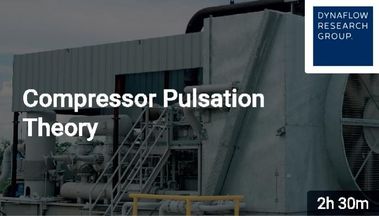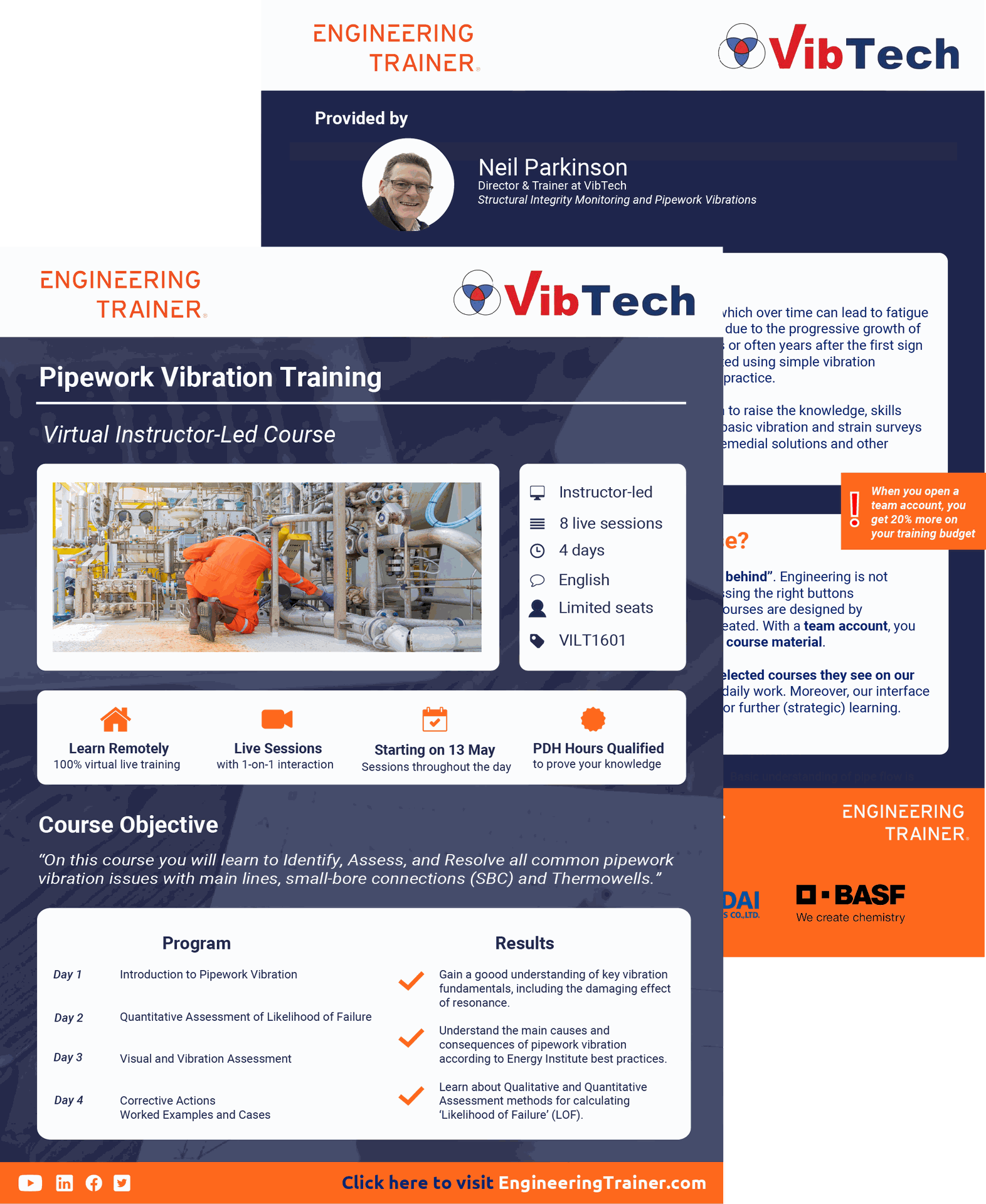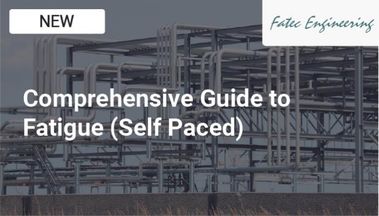Pipework Vibration Training
Starts 13 May 2024
20hr Content
4 day program
40 Credits
Neil Parkinson
VILT1601
Format:
Instructor-led
Reduced fees with a team account
Contact us to discover the benefits of a team account
Prefer a private in-company training?
Contact us to arrange one for this course.
Course Objective
“On this course you will learn everything you need to know to Identify, Assess, and Resolve all common pipework vibration issues with main lines, small-bore connections (SBC) and Thermowells on process pipework, in accordance with the Energy Institute best practice guidelines.”
Virtual Instructor-led
100% online training
Video Lectures by Experts
connect with them online
4 day program
Concentrated in one week
PDH Hours qualified course
Read more here
About the course
Instructor-led
20hr Content
8 live sessions
13 May 2024
4 day program
English
Limited seats
VILT1601
Many normal process operations can cause vibrations in pipework, due to a variety of excitation mechanisms, which over time can lead to fatigue fractures resulting in leaks. Vibration Induced Fatigue failures occur due to the progressive growth of fatigue cracks in welded connections due to fatigue mechanism.
Failure occurs weeks, months or often years after the first sign of the crack. At this point the crack has grown fully through-wall, resulting in a leak, often during an extreme event such as a pipe surge or pressure spike. Such fractures could lead to serious incidents involving major injury, fire, explosion or pollution. Many serious pipe vibration issues can be easily detected using simple vibration screening techniques and can be avoided by adopting industry best practice.
This course will provide a detailed introduction into pipework vibration to raise the knowledge, skills and confidence of engineers to be able to perform their own visual, basic vibration and strain surveys and assessments. It will also provide a good overview of common remedial solutions and other specialist techniques, and provide additional information on the selection and implementation of Braces, Visco-dampers and Dynamic Vibration Absorbers for corrective actions.
Emphasis is placed on both practical and theoretical aspects of the subject and covers in detail Quantitative Assessment Methods for the calculation of Likelihood of Failure (LOF) for main lines, small bore connections and Thermowells.
Meet your instructor
Neil Parkinson
Director & Trainer at VibTech
Structural Integrity Monitoring and Pipework Vibrations
Program & Details
Introduction to Pipework Vibration
Trainer Intro
VibTech Intro
Tips with using MS Teams
Course Format and Timescales
Multiple Choice Tests
Overview of Pipework Vibration
Introduction to Energy Institute publication ''Guidelines for the avoidance of vibration induced fatigue failure in process pipework'', 2nd edition, 2008 (current)
Definitions
Units of measurement
Introduction to Spectra
Natural Frequency
Forced Vibration
Resonant Vibration
Identifying the main excitation mechanisms causing pipework vibration:
Flow Induced Turbulence
Mechanical Excitation
Pulsation
Acoustic Induced Vibration
Surge & Momentum Change
Cavitation & Flashing
Small Bore Connections
Thermowells
Understanding the consequences which could lead to failures:
Fatigue
Fretting
Explanation of the key factors affecting fatigue life
Effects of Stress
Fatigue Endurance curves
Fatigue of Welds
Effects of Corrosion
Intro to BS 7608
Introduction to the various tools and techniques
Suggested sequence of events for investigation and assessment of risk of Pipework Vibration Fatigue
Review including Multiple Choice Questions
Quantitative Assessment of Likelihood of Failure
Intro to Qualitative and Quantitative Assessment
Method for assessment of potential excitation mechanisms.
Quantitative Assessment method for assessing the risk of Failure due to Flow Induced Turbulence
Primarily to understand key factors and their significance
Quantitative Assessment method for assessing the risk of Failure due to Mechanical Excitation
(e.g. Direct excitation from Machines or indirectly from other pipework)Primarily to understand key factors and their significance
Quantitative Assessment method for assessing the risk of Failure due to 3 types of tonal pulsations due to acoustic resonance
(reciprocating machines, rotating machines and dead-leg branches).Primarily to understand key factors and their significance
Quantitative Assessment method for assessing the risk of Failure due to high frequency Acoustic Induced Vibration (AIV)
Primarily to understand key factors and their significance
Quantitative Assessment method for assessing the risk of Failure due to Surge and Momentum change associated with fast acting valves
Primarily to understand key factors and their significance
Quantitative Assessment method for assessing the risk of Failure due to Cavitation & Flashing in liquid systems
Primarily to understand key factors and their significance
Review including Multiple Choice Questions
Visual and Vibration Assessment
Quantitative Assessment method for assessing the risk of Failure of Small Bore Connections (SBC), considering Geometric Factors and Location Factors for 4 generic configurations
Primarily to understand key factors and their significance
Quantitative Assessment method for assessing the risk of Failure of Thermowells due to flow induced vortices caused by flow of fluid past thermowell
Primarily to understand key factors and their significance
Introduction to alternative standard ASME PTC B19.3TW-2010
Learning Visual Survey techniques to identify pipework with increased risk of failure
Learning what to look for to identify good and bad practice Supported by library photo
Opportunity to try to identify some common examples of Bad Practice from Photo Library
Learning Vibration Survey techniques to identify pipework with increased risk of failure
How to setup a vibration meter and where to take measurements
How to process results and how to interpret results
Latest Energy Institute recommendations for instrument tubing covering protection against vibration for pipework and structure mounted instrumentation and allowance for large scale deformations (thermal expansion)
Introduction to a new 'Concern factor' for assessing and ranking Pipework Vibration results.
Review including Multiple Choice Questions
Corrective Actions
Introduction to other pipework vibration assessment techniques, including:
Strain Gauges
FEA
Motion Amplification
Operating Deflection Shape Analysis
Modal Analysis
Introduction to Strain Gauges, including where to measure strains
Fatigue Assessment methods
Review of corrective actions for solving vibration problems on Main Lines, including:
Flow Induced Turbulence
Mechanical Excitation
Pulsation
Acoustic Induced Vibration
Surge & Momentum Change
Cavitation & Flashing
Considerations for the use of Visco-Elastic Dampers to solve Main Line vibration issues.
Review of Corrective actions for solving vibration problems on Small Bore Connections (SBCs)
Introduction to Easy-Brace® universal SBC solution
Design considerations, relating to brace stiffness, the use of I-beams and the problems with thin-walled pipes
Introduction to VibTech Quantitative Assessment Tool (QAT) - performs all EI LOF calculations in Sections T2, T3 & T4 of EI Guidelines
Review including Multiple Choice Questions
Worked Examples and Cases
Worked Example - Main Line LOF - Gas Compression System
Worked Example - SBC LOF calculation Type 1
Worked Example - SBC LOF calculation Type 2
Worked Example - SBC LOF calculation Type 3
Corrective Actions Case Studies (AVT) - Easy Brace
Corrective Actions Case Studies (AVT) - Visco-Damper
Corrective Actions Case Studies (AVT) - Dynamic Vibration Absorber
Summary of Good Practice features for Main Lines, SBCs and Tubing
Most common mistakes
Summary of key learnings during the course
Results
After this course, you...
gain a good understanding of key vibration fundamentals, including the damaging effect of resonance.
understand the main causes and consequences of pipework vibration.
learn about Qualitative and Quantitative Assessment methods for calculating ‘Likelihood of Failure’ (LOF) for Main Lines, Small Bore Connections and Thermowells – supported by worked examples.
learn how to perform a visual assessment of pipework to be able to identify and prioritise potential areas of concern.
learn about portable vibration measurement instrumentation and how to perform basic vibration measurements and assessments against Energy Institute limits.
learn about the value of strain measurements and how to perform basic fatigue life estimates based on BS 7608.
learn what constitutes ‘good practice’ for avoidance of vibration induced fatigue.
have seen common pipework vibration solutions, including the selection and implementation of remedial pipe supports, including braces, visco-dampers and dynamic absorbers.
Who should attend this course
This course is tailored for Operators, Technicians, Engineers, Supervisors and Managers involved in any of the following areas:
Asset Integrity, Mechanical Inspection and Risk Based Inspection (RBI)
COMAH Compliance and Reliability
Pipe Stress and Piping Design
Plant Integrity, Plant Maintenance, Plant Safety and NDT
Process Engineering
Prerequisites:
Attendees do not require any prior knowledge of pipework vibration.
Ideally the attendees will have a good understanding of the use of pipework within process plants and have a technical aspect to their roles.
Good proficiency in basic mathematics.
Good understanding of the English language.
Level: Intermediate
This course consists of 4 instructor-led live sessions which consist of presentations, demonstrations, discussions and worked cases. During each session, participants can ask questions to the instructor (through the chat or microphone) which will be answered in the session.
Access to the course
After your purchase is confirmed the course will be available in your EngineeringTrainer account, where you will find the course welcome chapter and instructions on how to join the live sessions. Sessions are held using the software Microsoft Teams and a log-in link is provided for each session through the EngineeringTrainer portal. Live sessions can be joined using any device, including tablets and mobiles.
The live sessions for this course will take place at the following times (all times are 24hr clock):
Session 1: 13 May 2024, 9:30 to 12:00 CEST (Convert time-zone)
Session 2: 13 May 2024, 13:00 to 15:30 CEST
Session 3: 14 May 2024, 9:30 to 12:00 CEST
Session 4: 14 May 2024, 13:00 to 15:30 CEST
Session 5: 15 May 2024, 9:30 to 12:00 CEST
Session 6: 15 May 2024, 13:00 to 15:30 CEST
Session 7: 16 May 2024, 9:30 to 12:00 CEST
Session 8: 16 May 2024, 13:00 to 15:30 CEST
These sessions will include breaks at regular intervals
A personal digital certificate will be made available to each participant upon full attendance.
Example Certificate:
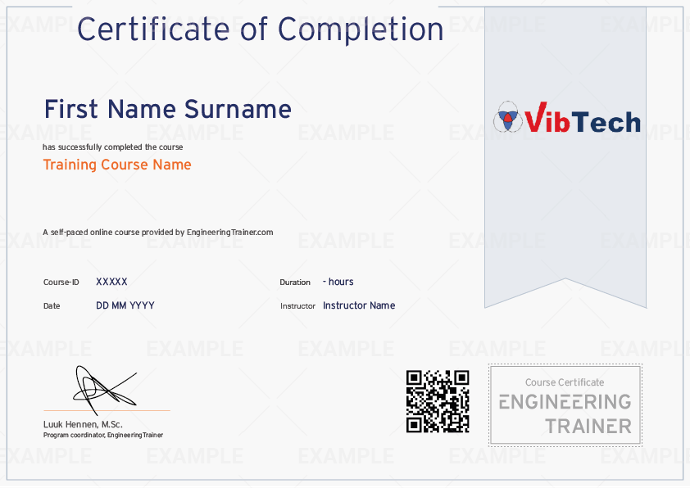
FAQ
This course consists of 4 instructor-led live sessions which consist of presentations, demonstrations and discussions of questions. During each live session participants can ask questions to the instructor (through chat or microphone) which will be answered.
Please note that for privacy reasons no recordings of the live sessions are made or provided.
The training material used in the live sessions, for example the slides or exercises, will be available in the EngineeringTrainer portal for a year after the date of the training allowing you to refresh your knowledge or review material if needed.
No, course content is not available for download.
The training material used in the sessions, for example the slides or exercises, will be available in the EngineeringTrainer portal for a year after the date of the training allowing you to refresh your knowledge or review material if needed.
Please note that for privacy reasons no recordings of the live sessions are made or provided.
Yes, interactive Q&A sessions are part of the live sessions in this course and allow you to interact with the instructor and ask questions.
To respect the privacy of the participants the live sessions will not be recorded, and as such the live sessions cannot be played back. Therefore it is important for all participants to block the time slots of the live sessions in their calendars and be present.
No software licenses are provided as part of this course.
Yes, this course qualifies for PDH hours as per the NCEES CPC Guidelines.
Related Courses
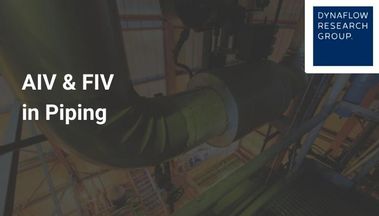
Self-paced
Acoustic and Flow Induced Vibrations (AIV and FIV) in Industrial Systems
By: Wijnand Schoemakers, MSc
